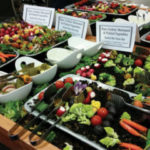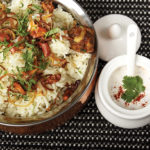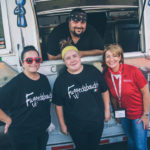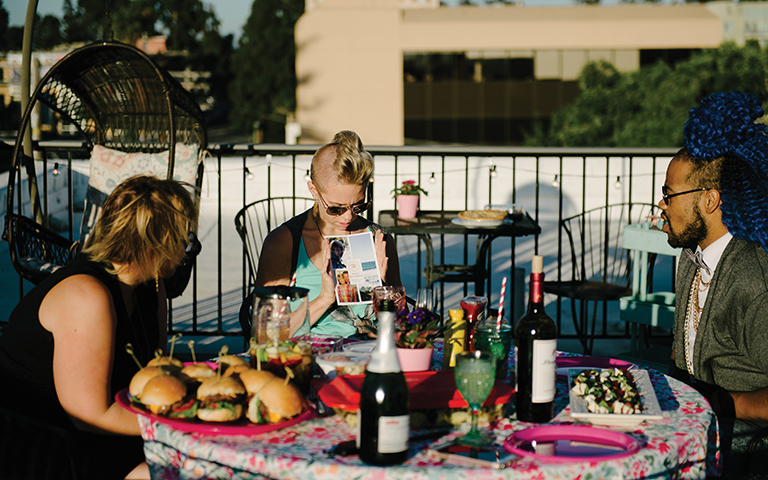
Planning a dinner among strangers often boils down to some key elements: a crowd-pleasing menu and ambience, as well icebreakers and small talk to keep the conversation flowing. But what happens when that small talk becomes “big” talk —conversations about big ideas? And what if the meal is memorable not necessarily because of what guests ate, but due to the stories they shared with one another?
Lennon Flowers, co-founder and executive director of The Dinner Party, discovered this in her mid 20s, as a recent Los Angeles transplant feeling disconnected from her East Coast roots — especially as she still quietly processed the death of her mother a few years before. When a new acquaintance, Carla Fernandez, learned of Flowers’ loss, she invited Flowers to a dinner party with a handful of other 20- and 30-somethings who had shared early loss.
We called it punk-rock grief support.
One dinner led to another, once a month. Eventually, those dinner parties began taking place in other cities, fueled by a growing network of young hosts and guests eager to talk about loss, and life, over potluck meals. “We called it punk-rock grief support,” Flowers said. “There was real power in telling your own truths, or seeing a head nod for something you felt crazy to share.”
BITE-SIZED CONVERSATIONS
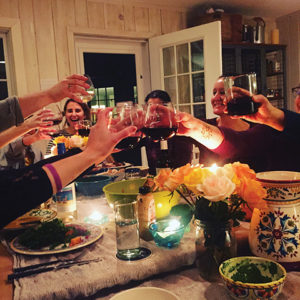
In 2013, with dinners growing steadily, Flowers and Fernandez formalized their model as a 401c3 organization called The Dinner Party. Hosts and potential guests could then reach out via The Dinner Party’s website, and guidelines were straightforward: Pick a date and place, anywhere from your own dinner table to a park. Send out invites — never more than eight or so guests, to keep each meal intimate — and, on the day of the event, create a welcoming vibe. Guests each bring a dish and, once seated, weave chitchat about their day-to-day lives with guided talk about, for example, advice they wish they could ask from their departed loved ones.
So far, 6,500 people in roughly 150 cities have volunteered to host or attend a Dinner Party dinner — so many that last fall, the organization suspended the acceptance of new “partiers” for a time. Concurrently, the team has translated the concept into new formats, including The People’s Supper, a partnership with the Faith Matters Network and Hollaback! to convene diners from diverse political backgrounds — a People’s Supper was part of the Oct. 31-Nov. 1, 2017 first-ever Obama Foundation Summit in Chicago on Oct. 31–Nov. 1) — as well as corporate loss-sensitivity training programs with firms such as Net Impact and Enso.
Flowers, 32, is keenly aware of how so-called “Millennial” her Dinner Party model is; she jokes that her age group has been dubbed “generation overshare.” However, the Gen Y influence is unmistakable: a thirst for shared experience that has turned the basic act of dining together into a participatory exercise with personal and social payoffs.
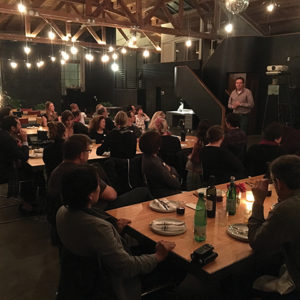
Raman Frey, the founder of another supper club, Good People Dinners, thinks this new generation of dinner parties is a refreshing diversion from what he calls “the transactional agenda” that characterizes professional interactions. “I think of our dinners as a respite from transaction fatigue,” Frey said. Good People Dinners of around 30 to 40 guests take place around the Bay Area, usually anchored by a speaker and discussion on topics such as confronting fears or the #metoo movement — plus a talk from each guest chef.
“Food and wine is secondary to what I do,” Frey said, although that doesn’t mean his chefs dial it back. At a November 2017 dinner, chef Elizabeth Binder turned out lemon-pepper-rubbed black cod and wild-huckleberry soup for a meal that also included a talk from expedition leader and adventurer Doug Stoup.
Frey, who has emceed 150 dinners so far, would love to see the model layered into conferences. “As human experiences, [conferences] are defined by linear and transactional thinking,” he said. “I wish someone would reinvent them to make them warmer.” To that end, Frey has begun to offer meal-based corporate “salons” for idea generation; his first one was for Mozilla.
LIVELY TALK ABOUT DYING
A few years ago, entrepreneur, former chef, and University of Washington teaching fellow Michael Hebb read some startling facts about dying — among them, that 75 percent of people want to die at home, but only a fraction actually do. Hebb surmised that people weren’t talking about death openly, so he planned “a large-scale intervention,” as he recounted during a TEDMED talk in 2013.
That year, with Angel Grant, Hebb founded Death Over Dinner (DOD) — meals intended to encourage people, including health-care providers, to talk openly about dying. “The table has always been where humans have grappled with the biggest issues we face, personally and culturally,” Hebb told Convene. The idea is that anyone can use the DOD model to plan a meal; so far, they’ve taken place in settings as diverse as country clubs, hospices, even a cemetery, sometimes with hundreds of people dining together (although those events are still broken down into smaller pods; see Breakout, p. TK.) Roughly 150,000 DOD dinners have taken place across the world, and DOD has partnered with organizations such as Vice Media, Thrive Global and the Cancer Society of Australia.
As with any dinner, icebreakers are key — particularly when it comes to a tricky subject. “Each dinner begins with a simple ritual of honoring a person who had a powerful impact on our life who is no longer living,” Hebb said, “and pets are allowed.” That ritual might include raising a glass or lighting candle.
We’ve had tremendous luck hosting these gatherings in almost every setting imaginable.
Despite that intimate, deeply personal spin, DOD has been a fit for some business meetings, such as TEDMED 2013 and the 2017 End Well Symposium in San Francisco. “Even though it may at first glance seem like too intense a topic for a conference or a large group, we’ve had tremendous luck hosting these gatherings in almost every setting imaginable,” Hebb said. “It is a flexible model; it works beautifully for a family of four, and we have successfully hosted up to 500 people at a death dinner. This is an unusual type of evening. It works best when thought and effort is put into the ambience, candles, low lighting, and great food.”
Small Talk
When it comes to sparking conversation, pop-up dinner organizers have a rule of thumb: Keep table sizes small. “I hate seeing tables of 10 or 20 people, because 20 people can’t have a conversation,” said The Dinner Party’s Lennon Flowers. “An ideal number is six to eight [people], and one host at each to lead a toast and kick off the conversation.”
To learn more, visit:
- The Dinner Party, thedinnerparty.org
- Death Over Dinner, deathoverdinner.org
- Good People Dinners, goodpeopledinners.com
F&B is supported by the Louisville Convention & Visitors Bureau, gotolouisville.com.


